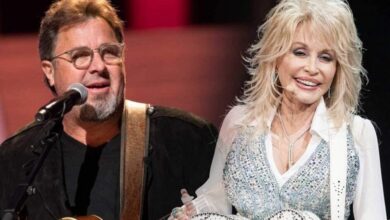This Popular Dance From The 1950s, Can You Remember It Now
In February 1958, American high school gyms and sock hops were transformed as a new dance craze took hold of the youth, capturing the vibrant essence of the era and epitomizing the carefree energy of rock ‘n’ roll’s early days. This dance, known as “The Stroll,” emerged as a line dance that quickly became synonymous with youthful exuberance and spontaneity. Originally rooted in African American culture, “The Stroll” found its way to mainstream popularity through television exposure, particularly on Dick Clark’s iconic show “American Bandstand.” The show introduced teenagers across the nation to the dance, allowing them to experience the infectious rhythm and joy that “The Stroll” embodied.
“The Stroll” was more than a mere dance; it evolved into a cultural movement that reflected the dynamic social changes of the 1950s. The format involved participants forming two lines, facing each other, effectively creating a lively aisle down the center. Couples would alternate strutting down this aisle, showcasing their dance moves while maintaining rhythm with the music. This structure encouraged both group participation and individual expression, making it particularly appealing to a generation eager to assert their identities against a backdrop of shifting societal norms. As teenagers embraced this dance, it served as a playful outlet for self-expression during a time when conformity often reigned supreme.
Central to the dance’s widespread appeal was the song “The Stroll,” performed by the Canadian vocal group The Diamonds. Renowned for their harmonious vocal style and catchy doo-wop melodies, The Diamonds played a pivotal role in propagating the dance craze beyond its origins. Their version of “The Stroll” was not just a hit; it became an anthem of a vibrant cultural movement, encapsulating the joy and rebellious spirit of the youthful performers. Lead singer Dave Somerville, with his rich baritone voice, captured the essence of the song, guiding dancers with his melodic and encouraging crooning. Under his lead, the group created an infectious sound that resonated deeply with the American youth.
The meteoric rise of “The Stroll” solidified its place as a fixture at social gatherings, particularly in high schools and community dance events. Its appeal was remarkably inclusive, adeptly bridging racial and social divides during an era marked by segregation and tension. The Stroll’s relatively simple and easy-to-learn choreography made it accessible to almost everyone, while its inherent vibrancy and coolness made it irresistible to teenagers eager to partake in the latest trends. Clad in their best outfits, youth flocked to dance floors, energizing the spaces with enthusiastic performances that showcased their newfound confidence.
As “The Stroll” gained traction throughout the United States, it came to symbolize a generation’s burgeoning desire for self-expression and enjoyment of newfound freedoms. The dance’s presence in popular media, particularly on shows like “American Bandstand,” cemented its status within the cultural zeitgeist of the time. Teenagers eagerly awaited their chance to not only dance but also to celebrate a communal experience that defined their shared youth. In a rapidly modernizing society, “The Stroll” offered an escape, an opportunity to relish carefree moments and create lasting memories with friends.
The impact of “The Stroll” extended well beyond its initial popularity, influencing the fabric of American pop culture. It became one part of a broader tapestry of 1950s youth culture that included music, fashion, and attitudes, all intermixed in a pursuit of joy and freedom. Its legacy continues, as modern generations occasionally resurrect the dance in nostalgic celebrations of the era. The echoes of laughter, music, and vibrant dance moves from those early days remain embedded in the collective memory, a testament to the unifying power of music and dance.
In examining the creation and proliferation of “The Stroll,” one acknowledges its roots that weave through various cultural and social contexts, showcasing how art can transcend lines of division. It demonstrated how teenagers, irrespective of race, could gather and share joyful experiences through a shared love of music and dance. As segregation began to bend under social pressures, dances like “The Stroll” became not just forms of entertainment but also a subtle assertion of unity and equality.
The Diamonds, as the champions of this movement, found themselves at the center of a whirlwind of excitement, largely credited for their contributions to the musical landscape of the time. The group came together in the mid-1950s, composing a sound that appealed to both mainstream and niche audiences. With an infusion of doo-wop and pop sensibilities, The Diamonds helped shape the soundscape of an era that valued harmony and melodious collaboration. Songs like “Little Darlin'” and “The Stroll” showcased their ability to connect with listeners on an emotional level, contributing to the heart of youthful experiences across the country.
Dave Somerville’s lead vocals became a defining characteristic of their sound, allowing listeners to connect deeply with the music. His distinctive baritone voice not only suited the upbeat nature of “The Stroll” but also imbued each performance with a sense of spirited joy and warmth. Beyond music, Somerville’s presence on stage inspired dancers and captivated audiences, establishing an enduring bond between performer and audience. The way he navigated melodies and rhythms allowed participants to immerse themselves in the euphoric atmosphere that enveloped their gatherings.
Ultimately, “The Stroll” serves as a nostalgic reminder of a bygone era, illuminating the ways in which music and movement fostered community and connection among youths during the 1950s. It remains an enduring symbol of a time when the lines of youth culture were drawn by the shared excitement of new musical trends and the joy found in dance, encapsulating the spirit of a generation eager to embrace life without reservation.
?si=CbHsPwTM-VodZAIG





